Monitor items related to CMPS on the service data.
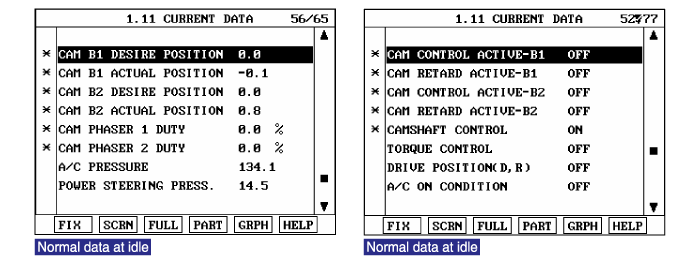
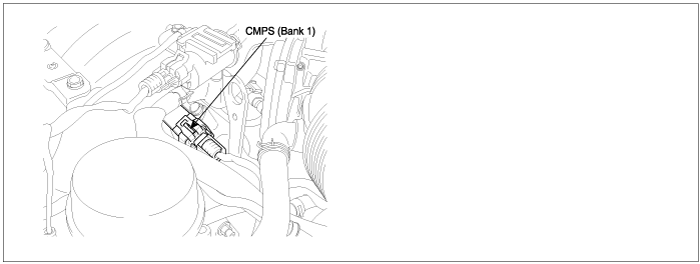
Camshaft Position Sensor (CMPS) is a hall sensor and detects the camshaft position by using a hall element. It is related with Crankshaft Position Sensor (CKPS) and detects the piston position of the each cylinder which the CKPS can’t detect. The two CMPS are installed on engine head cover of bank 1 and 2 and uses a target wheel installed on the camshaft. This sensor has a hall-effect IC which output voltage changes when magnetic field is made on the IC with current flow. When teeth on the target wheel trigger the sensor, output voltage is 5V. If not, it is 0V. These CMPS signal is sent to the PCM and it uses CMPS signals for determining the ignition timing with CKPS signals. CMPS makes Sequential Injection possible.
If PCM detects that cam event signal count is over 3 under detecting condition, PCM sets P0340. MIL(Malfunction Indication Lamp) turns on when the malfunction lasts till consecutive 2 driving cycle.
Item | Detecting Condition | Possible cause | |||||
DTC Strategy | ● Check if CAM sensor is synchronized correctly | ● Poor connection ● Open in harness ● CMPS(Bank 1) ● PCM | |||||
Enable Conditions | ● Engine running state | ||||||
Threshold value | ● Cam evnt signal count ≥ 3 | ||||||
Diagnosis Time | ● Continuous | ||||||
MIL On Condition | ● 2 driving cycles | ||||||

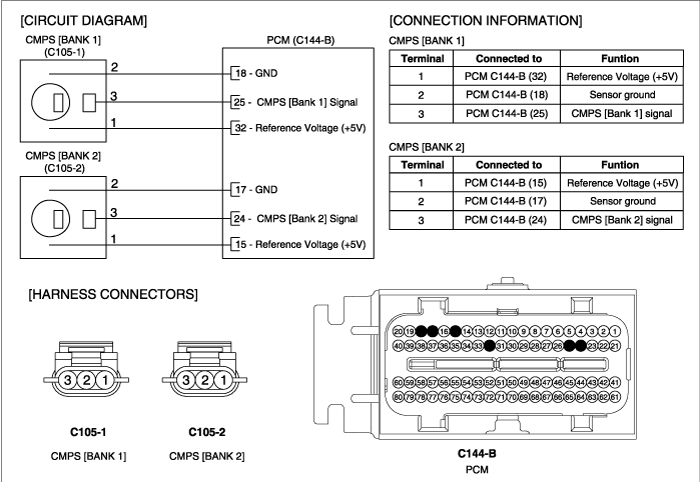
IG "OFF" & connect scantool.
ENG "ON" and warm -up the engine to normal operating temperature.
Monitor items related to CMPS on the service data.

Is the service data displayed correctly ?

▶ Fault is intermittent caused by poor contact in the sensor’s and/or PCM’s connector or was repaired and PCM memory was not cleared. Thoroughly check connectors for looseness, poor connection, ending, corrosion, contamination, deterioration, or damage. Repair or replace as necessary and go to "Verification of Vehicle Repair" procedure

▶ Go to "Terminal and Connector Inspection" procedure
Many malfunctions in the electrical system are caused by poor harness and terminals. Faults can also be caused by interference from other electrical systems, and mechanical or chemical damage.
Thoroughly check connectors for looseness, poor connection, bending, corrosion, contamination, deterioration, or damage.
Has a problem been found?

▶ Repair as necessary and go to "Verification of Vehicle Repair" procedure

▶ Go to "Power Circuit Inspection" procedure.
IG "OFF" and disconnect CMPS connector.
IG "ON" and ENG "OFF"
Measure voltage between terminal 1 of CMPS(B1) harness connector and chassis ground.
Specification : Approx. 5V
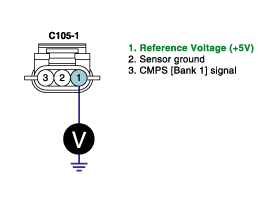
Is the measured voltage within specification?

▶ Go to "Signal Circuit Inspection" procedure.

▶ Repair open or short to ground in harness, and go to "Verification of Vehicle Repair" procedure.
Check voltage
IG "OFF" and disconnect CMPS connector.
IG "ON" and ENG "OFF"
Measure voltage between terminal 3 of CMPS(B1) harness connector and chassis ground.
Specification : Approx. 5V
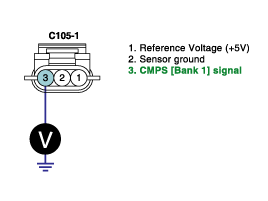
Is the measured voltage within specification?

▶ Go to "Component Inspection" as follows.

▶ Go to "Check open in harness' as follows.
Check open in harness
IG "OFF" and disconnect CMPS connector and PCM connector.
Measure resistance between terminal 3 of CMPS harness connector and terminal 25 of PCM harness connector.
Specification : Below 1Ω
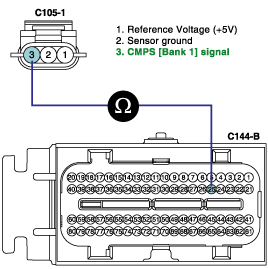
Is the measured resistance within specification?

▶ Go to "Ground Circuit Inspection" procedure.

▶ Repair open in harness, and go to "Verification of Vehicle Repair" procedure.
IG "OFF" and disconnect CMPS connector.
Measure voltage between terminal 3 of CMPS harness connector and chassis ground.
Measure voltage between terminals 2 and 3 of CMPS harness connector.
Specification : Measurement "A" - Measurement 'B' = Approx. below 200mV

Is the measured voltage within specification?

▶ Go to "Component Inspection" procedure.

▶ Repair open or contact resistance in harness, and go to "Verification of Vehicle Repair" procedure.
Check CMPS
IG "OFF" and connect scantool.
ENG "ON" and Measure signal waveform at terminal 3 of CMPS.

Is the measured siganl waveform normal?

▶ Substitute with a known - good PCM and check for proper operation. If the problem is corrected, replace PCM and go to "Verification of Vehicle Repair" procedure.

▶ Substitute with a known - good CMPS and check for proper operation. If the problem is corrected, replace CMPS and go to "Verification of Vehicle Repair" procedure.
There is a memory reset function on scantool that can erase optional parts automatically detected and memorized by PCM. After testing PCM on the vehicle, use this function to reuse the PCM on the others
After a repair, it is essential to verify that the fault has been corrected.
Monitor and record the Freeze Frame Data for the Diagnostic Trouble Code(DTC) which has been diagnosed.
Using a Scantool, Clear the DTCs
Operate the vehicle within conditions noted in the freeze frame data or enable conditions
Monitor that all rediness test have been verified as " Complete "
Are any DTCs present ?

▶ Go to the applicable troubleshoooting procedure.

▶ System is performing to specification at this time.